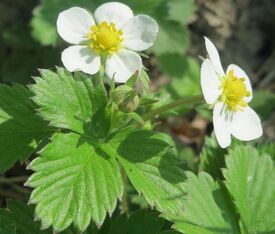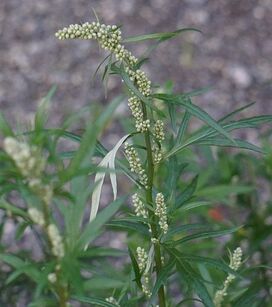Under the oaks and evergreens at 7420 feetWILD STRAWBERRY Wild strawberry runs along the trail. Tea of strawberry leaves and stems is valued for its mild astringent effects, and its antirheumatic, diuretic, antidiarrheal, tonic, and laxative properties. Strawberry is recommended in many traditions for intestinal sluggishness and for pregnancy, convalescence, and chronic stomach sensitivity when stronger herbs are contraindicated. WORMWOOD Known variously as 艾叶 (aiye), artemisia, or mugwort, wormwood is an intense bitter that stimulates underactive digestion and aids anemia. An anti-inflammatory and antidepressant, wormwood can be added as a potentiating factor to other preparations. Its active substances include essential oils, sesquiterpene lactones, azulenes, flavonoids, phenolic acids, and lignans. The whole plant is used as an antimalarial. Wormwood herbal tea is administered as a stomach stimulator and orexigenic. In Chinese medicine, wormwood warms the channels and stops bleeding. It dispels cold and alleviates pain, calms the fetus, resolves phlegm, and stops cough and asthma. As an aromatic, wormwood is used in sweat baths and saunas. Wormwood-juniper smudge sticks cleanse spaces and purge negativity. VERBENA The constituents of verbena or 马鞭草 (mabiancao, literally, horsewhip herb) include volatile oils, bitters, iridoids, alkaloids, mucilage, and tannins. It is a restorative, helpful for tension and long-term stress and good for convalescence from a long illness. The entire plant has sedative, tonic, diaphoretic, and anti-inflammatory properties and it is used to treat early-stage depression, melancholia, stress, and fever. Chinese medicine employs the bitter and cool properties of verbena to clear heat and remove toxicity, activate blood, disperse nodules, promote diuresis, and resolve swelling. It is indicated for jaundice caused by damp-heat, for fever due to external pathogens, and for dysmenorrhea or amenorrhea from blood stasis and abdominal masses. Its heat-clearing properties are used for severe sore throat and other accumulations of heat toxin including breast abscesses and swollen and painful gums. Extracts of lemon verbena and its major compound acteoside (ACT) have a regulatory effect on abnormal liver lipid metabolism; furthermore, ACT promotes lipolysis and fatty acid oxidation by increasing messenger RNA expression of adipose triglyceride lipase and carnitine palmitoyltransferase. OAK TREE The leaves, acorns, galls, and branches of oak trees contain tannin, quercetin, gallic acid, pectin, calcium, magnesium, and potassium. In various medical traditions, infusion of oak tree bark is administered internally to treat hemorrhoids, diarrhea, chronic dysentery, intestinal bleeding, and uterine bleeding, and, as a tea astringent, oak is applied externally to skin wounds, burns, mouth inflammation, toothaches, sore throats, and earaches. Oak gall possesses astringent, anti-inflammatory, antiviral, antidiabetic, larvicidal, antibacterial, and gastroprotective effects. Gallnuts have been sourced to produce drug therapies for cancerous diseases in traditional and folk medicine systems through the centuries, and the literature indicates that gallnuts contain a number of bioactive metabolites, accounting for their anticancer effects. Further screening of bioactive compounds is expected to yield valuable anticancer agents. JUNIPER The medicinal evergreen juniper or 杜松子(dusongzi) is resinous and aromatic. Internally, the leaves or berries have been used as a urinary antiseptic and for cystitis and urethritis, although juniper is contraindicated in people with kidney infection or chronic kidney weakness as the oils may be irritating to kidney inflammations. Juniper berries have diaphoretic and emmenagogue properties and the leaves have diuretic properties. In Chinese medicine, juniper works at the heart, spleen, and lung meridians and its key actions and medicinal uses include promoting digestion, warming the middle burner, expelling phlegm, warming the lungs, and cleansing the kidneys and liver. Topically, juniper is used to treat chronic skin irritations and as a relaxant. It relaxes the muscles and removes barriers to blood flow and energetic flow. Juniper is prized in many traditions for its ability to dispel tension and stagnation and the aromatic parts of the juniper plant have been employed as a protector against negativity. Juniper is known to have a stabilizing presence for those in need of safety and protection. Juniper's versatility extends to the culinary world and includes the flavoring of meat and sauerkraut and the distillation of gin. Please note: The herb information in this blog is presented for educational purposes only. The use of herbal preparations is not recommended without seeking the advice of a healthcare provider. Substances in herbal preparations may interact with prescription drugs to eliminate therapeutic efficacy or induce toxicity.
1 Comment
Identifying local herbsBEAR CORN Bear corn or 肉苁蓉 (roucongrong) emerges from the soil under the oaks. A root parasite lacking chlorophyll, bear corn searches the dark soil to feed off the root system of the host tree. These New Mexico specimens are yellow and resemble ears of corn. In the words of Culpeper, “The juice or decoction of the young branches or seed, or the powder of the seed taken in drink, purgeth downwards and draweth phlegmatic and watery humors from the joints, whereby it helpeth the dropsy, gout, sciatica, and pains in the hips and joints.” Bear corn serves as an astringent, a poultice, a laxative, and a sedative. It restores strength, muscle tone, and balance after a long illness. In Chinese medicine, bear corn is a tonic to kidney-yang and a demulcent laxative; it tonifies yin as well as yang, lowers blood pressure, and is prized as an aphrodisiac and a uterine hemostatic. Modern research indicates that phenylethanoid glycosides isolated from bear corn may be effective in treating hot flashes and menopausal syndrome. YARROW The wet spring has produced a bumper crop of fernlike yarrow. Also known as thousand-leaf, yarrow is an important species in the traditional medicine of many cultures. It is antispasmodic, astringent, bitter, diaphoretic, and anti-inflammatory, and its constituents include coumarins, tannins, alkaloids, flavonoids, lactones, volatile oils, and triterpenes. Internally, yarrow is used to break fevers and to regulate the menstrual cycle, reduce heavy bleeding, and relieve menstrual pain. Externally, a salve or ointment of yarrow heals wounds and eases the pain of varicose veins. Yarrow has been used as a battlefield remedy for its ability to stanch bleeding and its antibacterial properties. Soldiers applied powdered yarrow or fresh yarrow leaves and flowers to stop wounds from bleeding. CLEMATIS Clematis or 威灵仙 (weilingxian) grows vertically on rocky roots as a vine with sparse, four-petal, nodding mauve flowers. Clematis has analgesic, anti-inflammatory, diuretic, and antimicrobial properties and its synergistic nature increases the effectiveness of other herbs. Clematis tea both acts as a vasoconstrictor on brain lining and dilates blood vessels -- it is used to treat headaches and migraines. Externally, a poultice of clematis leaves treats rheumatic pain. Known as “the holy root of the temple” in Chinese medicine, clematis removes wind and dampness, facilitates passage of meridians, and relieves pain. Experimental studies have demonstrated the antirheumatic and analgesic effects of clematis and saponins isolated from clematis may induce apoptosis in breast cancer cells via the mitochondrial pathway. Triterpene saponins from the roots and rhizomes of Clematis mandshurica show inhibitory activity against human colon cancer cell lines. VALERIAN Valerian or 缬草 (xiecao) clings to the rocks nearby. Also known as all-heal, valerian's use as a medicinal herb was documented in ancient Greece. Pliny said that the powder of valerian root given in drink, or the decoction thereof taken, helps all stoppings and stranglings in any part of the body. And Culpeper recommended the root of valerian boiled with licorice, raisins, and aniseed as singularly good for those who are short-winded and for those who are troubled with the cough, to open passages and expectorate phlegm easily. We scratch the root and smell the pungent odor of its chemical constituent valerenic acid. Acting at the central nervous system, valerenic acid and its derivatives have soothing, sedative, spasmolytic, digestive, and hypnotic properties. Physiologically active iridoid valepotriates may cause the release of GABA from nerve endings and block its return to nerve cells, and valerenic acid is known to inhibit an enzyme that destroys GABA. Herbal tea from valerian root has been used for anxiety, tension, hysteria, insomnia, and pain. Valerian root is approved in Europe for mild anxiety and to aid sleep. In Chinese medicine, valerian possesses pungent, bitter, and warm properties and enters through the liver and heart meridians. It acts to induce tranquilization, stop bleeding, and alleviate pain. Valerian root is indicated for irregular menstruation, traumatic injury, back pain, neurasthenia, and indigestion. CORYDALIS Corydalis, also known as golden smoke, scrambled egg, or 延胡索 (yanhusuo), is among the first herbs to flower in spring. An herbal tea of the fumewort corydalis has hypnotic and analgesic properties and is used for stomachache and headache. The Ojibwe people placed the root on coals and inhaled the smoke to clear the head and calm the patient. In Chinese medicine, corydalis invigorates the blood, moves qi, alleviates pain, and reduces masses; thus, it is indicated for pain due to blood stasis and qi stagnation such as epigastric pain and dysmenorrhea. Corydalis contains 20 alkaloids, among them corydaline, tetrahydropalmatine, protopine, and tetrahydrocoptisine, and in laboratory research has exhibited pharmacological action on the central nervous system, including analgesic and sedative effects. Corydalis may block certain receptor sites in the brain, inducing sedation. Its alkaloids may also have cardiovascular effects. Please note: The herb information in this blog is presented for educational purposes only. The use of herbal preparations is not recommended without the advice of a healthcare provider. Substances in herbal preparations may interact with prescription drugs to eliminate therapeutic efficacy or induce toxicity. Nature's pharmacyJust 24 minutes outside the city of Albuquerque in the East Sandia Mountains of New Mexico, at an elevation of 7420 feet, the wet winter and cold spring have yielded a bounty of herbs. Our guide points out filaree, mullein, hawthorn, dandelion, bear corn, yarrow, clematis, valerian, corydalis, strawberry, wormwood, and verbena among the pines and oaks along the trail. FILAREE
MULLEIN
HAWTHORN
DANDELION
Information in this blog is presented for educational purposes only. Not intended to diagnose, treat, cure, or prevent any disease. The use of herbal preparations is not recommended without seeking the advice of a healthcare provider. Substances in herbal preparations may interact with prescription drugs to eliminate therapeutic efficacy or induce toxicity.
|
�
AuthorKerilyn Sappington is the founder of Integrative Translations, which specializes in the Chinese to English translation of topics in conventional and complementary medicine. Archives
August 2022
Tags
All
|














